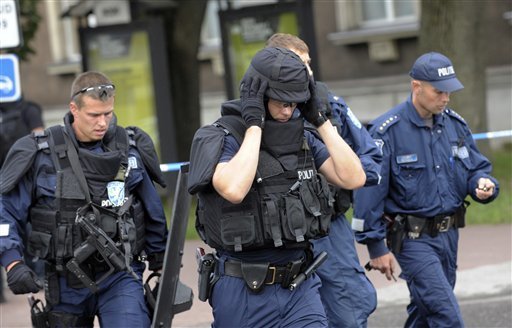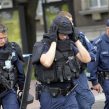
Terrorist Incident At Defense Ministry In Tallinn
Publication: Eurasia Daily Monitor Volume: 8 Issue: 158
By:

On August 11 in Tallinn, an armed member of the local neo-Soviet milieu forced his way into Estonia’s defense ministry, fired pistol shots, detonated smoke bombs, and took two hostages. In a two-hour confrontation with the security police, the intruder did not answer appeals to desist. He attempted to force his way from the ground-floor lobby deeper inside the building, wounded a policeman, and was fatally shot during the shoot-out. The intruder was equipped with two pistols, approximately 100 bullets, and ten smoke bombs. He did not air political demands during his action and did not claim to act on behalf of any group, although he was a member of the minuscule “United Left Party.” This is the first act of terrorism with the use of firearms in Estonia, and the first case of anti-state violence since the riots of local Russian youth in 2007.
The perpetrator, Karen Drambian, born in 1954 in Yerevan and raised in Moscow, was transplanted to Estonia with the organized influx of Russians and Russified Soviet citizens into the Baltic States. He studied law during the 1980’s, received Estonian citizenship in 1993, had his own law practice, and joined the United Left Party, which claims to be a direct successor to the Communist Party of the Soviet Union (CPSU) in Estonia. He ran unsuccessfully for a council seat of the Maardu municipality, counting in vain on local Russian voters. As a lawyer, Drambian defended militants of Nochnoy Dozor [Night Watch], the Russian youth group that sparked devastating riots in 2007, in response to the relocation of the Soviet Soldier’s monument from downtown Tallinn (BNS, Delfi, Postimees, August 12-15).
Some political tracts, signed by Drambian in recent years, have been discovered in obscure outlets after his August 11 attack, thus achieving some notoriety for the first time. He had published these texts in the ephemeral newsletter “Vesti Dnya” (no longer printed) and internet portals such as Slavia.ee. Drambian’s texts depict the state of Estonia as “neofascist,” conducting an undeclared “civil war” against the non-indigenous (Russians/Russian-speakers), impoverishing these for the benefit of Estonians, and enriching Estonia’s ruling stratum by exploiting “the people” as a whole. At the same time he describes local Russians as apathetic and misled to “vote for the hypocrites” [apparently alluding to the Center Party’s lock on most non-indigenous voters]. While passionately identifying with the “Russian-speaking” part of the population, Drambian decries “Russian man’s unique capacity to suffer, suffer, grate his teeth and suffer more” (www.gazeta.ru, August 13; Delfi, August 12-15).
According to leaders of the Armenian community in Tallinn, Drambian was not a registered member and had no connection with this community (Armenpress, PanArmenianNet, August 12, 13).
His party comrades and other “anti-fascists” have failed to criticize Drambian’s terrorism act. They are only citing an unhappy turn in his life and expressing compassion. According to them, Drambian was deeply indebted and had forfeited his car and his apartment last year to a bank. He was mostly out of legal work due to inadequate knowledge of the Estonian language. Although he had somehow passed the test for acquiring Estonian citizenship, he was not proficient in the language. (This was a common occurrence when Estonia opened a wide door to citizenship for Soviet-era settlers, easing the language tests).
Drambian’s case is unprecedented as a terrorism case in Estonia. The background and antecedents, however, reflect a late-Soviet and post-Soviet social process, affecting non-indigenous groups (Russians and others) particularly in Estonia and Latvia. There, Moscow has promoted an amalgamated identity for all non-indigenous groups as “Russian-speaking population,” with corresponding forms of organization, demarcated from the native societies, and defined in opposition to the governments. This perpetuates alienation among these groups and the perception of “rootlessness,” of which Drambian complains in his polemics. He was himself twice uprooted (Armenia-Russia-Estonia), a situation by no means uncommon among such “stranded” groups. While his resort to terrorism is an individual act, unrepresentative perhaps even of the fringe group to which he belonged, that milieu has produced Drambian and has apparently failed to disavow his terrorist act. This is partly the same milieu that spawned the 2007 mass riots.
Defense Minister Mart Laar and other Estonian officials have asked law-enforcement agencies to investigate whether the attack on the defense ministry might have been inspired by inflammatory rhetoric from Moscow in recent weeks. From July 31 onward, a series of statements from Russia’s foreign ministry accused Estonia of glorifying Nazism and its collaborators, spreading neo-Nazi ideas, and attempting to revise the assessment of the Second World War (Interfax, August 1-8). Russian television channels played it all up.
Those accusations were pegged to Estonia’s annual reenactment of the 1941 Erna raid, and annual commemoration of the 1944 Sinimae battle. The Erna raid, undertaken by Estonian volunteers from Finland in coordination with German troops, attacked the retreating Soviet forces in July 1941, saving a number of Estonian villages from scorched-earth destruction, and their population from deportation. In the Sinimae battle of summer 1944, Estonians and Germans made a last-ditched attempt to hold off the Soviet re-occupation of Estonia. By delaying the Red Army’s advance, the defense of Sinimae enabled many Estonians to flee westward, many of them avoiding likely deportation to Siberia.
The Erna raid reenactment and Sinimae battle commemoration are regular annual events with international participation. Moscow condemns them every year, in line with the general Russian policy to “criminalize” any defense, by any state or non-state actors, against Soviet or Russian forces, retrospectively and prospectively. Whether this year’s round of condemnation inspired the August 11 attack on Estonia’s defense ministry seems far from ascertainable. That particular message from Moscow comes every year in unchanging form.




